There are smartphones, smart homes – and now even our textiles are getting smart. Their practical potential is already being tested by the emergency services, but smart textiles are also set to conquer the world from medicine to fashion and, maybe soon, our everyday lives.
Malte von Krshiwoblozki speaks to RealIZM about his current projects and future vision.
What is your history with Fraunhofer?
Malte von Krshiwoblozki: I studied microsystems technology at the FHTW and then joined the Fraunhofer in 2007 during my practice semester. I graduated in 2009 and stayed on as part of the ‘System on Flex‘ group. This brought me into contact with the whole topic of smart textiles right from the start. And now, I am in charge of the ‘System on Flex’ group and all textile-related activities.
Did you have a particular vision you wanted to pursue after your studies?
Malte von Krshiwoblozki: Well, not really, to be honest. I studied microsystems technology, which means that you have little to do with smart textiles at first. The first time I came into contact with smart textiles was when it came to conductive cleanroom suits. Other than that, this topic was – and, frankly, still is – very exotic. I always thought that I was going to end up in a classic field of microsystems technology. That is why everything here was quite a surprise to me too. It just happened like that.
And yet here you are: Could you walk me through the topic ‘smart textiles’?
Malte von Krshiwoblozki: I prefer the term ‘electronic textiles’ or “e-textiles” now, since ‘smart textiles’ also refer to textiles made from smart materials like shape changing polymers that have no electronic functionality. E-textiles can be used in a wide variety of areas. The first you might think of, of course, is a dress that lights up, or the fashion industry more generally. But these are markets where e-textiles will probably only end up later on. In the short or medium term, the medical technology markets and others are much more interesting. You can get really close to the human body, you can build comfortable, breathable systems to scan vital signs. Protective clothing for professional use is another big topic. Just think of firefighters, who could have a kind of energy and data network in their clothing that would allow them to plug in any wearable device they need in an emergency.
The sports sector also has a lot of potential. Motion analysis allows you to record the movements of an athlete’s body with textile sensors and to draw certain conclusions from this information.
Muscle activities can be measured with electromyogram (EMG), or you could actually stimulate muscles with electric pulses. Besides, regular ECG measurements are also possible. Everything to make training more efficient and avoid overtraining is of interest in the wearables area.
What we often forget is that textiles are actually a much bigger field: You come home and step on a carpet, sit on a couch. In your car, everything is upholstered with textile products. There is great potential for us to introduce new functionalities in these products. This can be considered a worthwhile opportunity to create new business models.
For example, think of electric mobility: In an electric car, the waste heat from the engine is negligible. An electric engine does not produce as much waste heat as the internal combustion engine. So you have to think about how to heat the passenger compartment during cold weather. This could be achieved using textile heating surfaces integrated into the cladding.
With this many different markets for smart textiles, you cannot really be focused on any one specific field, but rather have to spread yourself out. If you specialize, you do so more in one of the underlying technologies that can then be adopted in different fields.
Do you have a key field of expertise for e-textiles at IZM?
Malte von Krshiwoblozki: Of course, we stay with the core topics of our institute: packaging and interconnection technologies. We think about how we can connect electronic modules and components with textiles as efficiently and as appropriately as possible for the material. For example, standard soldering processes would not work with many textiles on an industrial level. This is because textiles cannot withstand the temperature, and solder joints usually do not cope that well with getting bent or put in the washer. We are developing new alternatives, such as adhesive technologies where the modules are mechanically and electrically connected. We have also developed stretchable printed circuit boards. We are currently spinning this further, so that we now have stretchable printed circuit boards in which the conductors are no longer based on copper foil or printed silver paste. We are utilizing fully conductive fabrics that are already very robust by nature. We then structure these with a laser and subsequently embed them into an elastic polymer. The polymer insulates the conductive fabric where necessary, makes it more robust, and allows easy integration into textile products.
What else is in progress at the moment?
Malte von Krshiwoblozki: We are expanding our contacting technology capabilities and converting everything to a larger dimension. Adhesive bonding involves bonding electrical modules to textiles with integrated conductors. This creates a mechanical and electrical connection in one process step. It allows many contacts to be contacted at once, and it even supports insulated conductors if the insulation is designed to match the process. We are currently developing this further on textile tapes, which we could use as an add-on webbing system for protective workwear or as highly robust belts e.g. for medical applications.
Introducing completely new products to the market is difficult. If an existing product portfolio can still be used and you bring in add-on upgrades, that hurdle might be lower. And since such add-ons can be easily removed, this has no effect on standard logistics, such as cleaning. Keep in mind that most customers are still not aware of e-textiles at all and might be wary about this new technology.
Is there an application that we can already see in everyday life?
Malte von Krshiwoblozki: We have a medically focused FMD project with a start-up and the Fraunhofer Heinrich Hertz Institute to help patients who have lost their sense of touch in their hands. If they do not see their hand, they cannot tell whether they are holding something. They are also not able to feel how hard they are squeezing. The HHI institute is working on a sensor glove, and we at IZM are developing a vest with 16 textile-integrated vibration motors. This allows the patient’s body to receive signals through an additional communication channel without using the visual or auditory track. By vibrating at sixteen spots on your back, an algorithm and a specific language can transmit specific information from the sensor glove.
The haptic language is developed by the start-up. The goal for the glove is to measure information and pass it on through vibration.
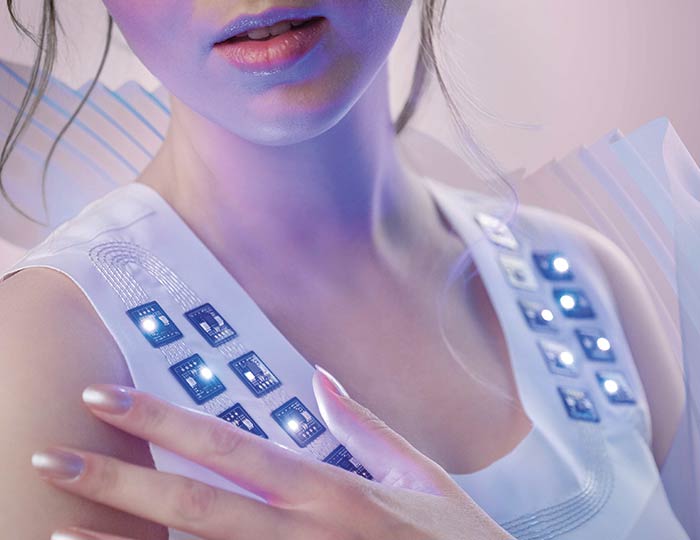
EU project Re-Fream – Second Skins designed by Malou Beemer
The garment consists of three layers. Undergarment: With integrated LED modules that generate light. Diffuse layer: This changes the light with the help of Profactor. Upper layer: This gives the garment its final shape. The wearer can upload their own LED color patterns and adjust them using a tap sensor. The ability to customize colors, patterns and textures extends the life of the garment. | © Fraunhofer IZM I Patrik Klein Meuleman
Is there any technology you developed that you are particularly proud of?
Malte von Krshiwoblozki: I mentioned the contacting technique earlier. We call this ‘adhesive bonding’. This is adapted from raw microsystems technology. We know from microelectronics that chips are applied with the flip-chip method, where the contacts are oriented directly downwards. We have now adapted this process to textiles. Adhesive bonding was also the topic of my diploma thesis. I have continued to develop the technology ever since then. I am enthusiastic about transferring this into the industry soon.
Where would you like to be in a year?
Malte von Krshiwoblozki: E-textiles have been a topic for a long time now. At the institute, the first projects were executed in 1999, and I have been working in this field for more than 12 years. But if you look around in a department store or out and about, these products are still very rare indeed. There are a few niche products that already use e-textile technology, but everything is going very slowly. It would be great if we made the leap to industrialize all of this and really bring it to the market in the near future.
What does the market look like? Have any competitors emerged?
Malte von Krshiwoblozki: There is definitely competition. Above all, there are many different approaches being pursued in this area, all of which are viable and promising. What I have noticed lately is that more and more major companies like Google or Microsoft have projects in this field and actively invest money to promote it. There are many start-ups as well; there is a lot of capital invested in these companies. You can see that there is a huge push going on, so I am convinced that, sooner or later, there will be a good market for it. The challenge is to position yourself so intelligently that you will still be in demand in five years’ time.
Does the IZM have a unique selling point to get such a position in the industry?
Malte von Krshiwoblozki: Absolutely. We are very well positioned in terms of contacting technology, highly robust e-textiles, and testing and analytics as well. There are many institutes that deal with the topic of e-textiles in general: from electronics or the textile side. They usually tend to be better in a specific sub-area. But when it comes to bringing these things together, we have a unique selling point. The equipment and our years of research alone have given us a lot of experience, and I believe we are in a very good position.
Are there any current projects you can tell us about?
Malte von Krshiwoblozki: Among lot of other things, we are currently running ‘Refream’, an EU project in which we are part of the Berlin hub. Artists are presenting their ideas and applying for technology funding. Within a certain budget, they have the opportunity to use the technologies we provide to build next gen e-textile prototypes. But that is not all there is: We are working with our colleagues from the environmental engineering department to look into the environmental impact of these approaches and the potential for the circular economy
Another project is the ‘Textile Prototyping Lab‘ funded by the Ministry of Education and Research. The aim is to establish a central and a local laboratory with other partners from Germany, where fast smart textile prototyping can be done. The difficulty for many companies (especially SMEs) is to guarantee the necessary textile and electronic know-how and the necessary financial and time investment in advance. Besides this, getting machine time for trying new things is often problematic. This is where the Textile Protyping Lab can help. The aim of our project is to provide input for textiles, design, and electronics and the equipment, so that prototypes can be produced quickly.
Is it sometimes difficult to manage the balancing act between being a serious researcher and fooling around, inventing color-changing shoes for example?
Malte von Krshiwoblozki: (laughs) There are certainly some colleagues who like to have a laugh in this sense. And of course, we have technologies and very cool means and equipment here in the house. Sometimes, you come up with ideas that you would like to implement right away, which is great and also important for research, but unfortunately you do not always have the time.
However, I am satisfied at the moment with the path my career is taking. I like to look at everything from a bird’s eye perspective and control it in such a way that I get where I wanted to get in the end. That is also important if you want to avoid developing tunnel vision and developing things that shoot past what people actually need.
Alexa and Siri are part of our lives already – will we be talking to our clothes soon? Is that even an issue?
Malte von Krshiwoblozki: When I talk about e-textiles, I usually mean the technologies behind them. It is a big challenge to get all this ready for the market. A computer has a hard and solid case and is electromagnetically shielded. Textiles, on the other hand, are moved and bent every day. Besides, the user is actually inside the electronic system. The textiles are washed hot and cold; they generally get wet and come into contact with sweat and dirt. These are extremely tough conditions. Think about how fast normal T-shirts wear out after a few washes. If you now add electronics with conductor paths to these textiles, whose resistance must be guaranteed over the entire service life, this represents an extreme challenge.
Voice control itself does not have to be reinvented for clothes. All you have to do is supply a new add-on and connect it – theoretically, that is just business as usual. But the actual challenge is somewhere else for now.
When the time comes, will it be just a luxury product or will it be affordable for the average consumer?
Malte von Krshiwoblozki: In the fashion sector, it will probably be high priced at the beginning, or the products won’t last long. The really good things will only come when all these manufacturing technologies have been established in the professional sector, such as protective clothing, medical technology, professional sports, etc. Once the technologies have matured enough so that you can upscale production – produce at low prices – then you can also expect reasonable, affordable fashion products, I would think.
Since this is now often mentioned when fashion is discussed: What about sustainability in the field of e-textiles?
Malte von Krshiwoblozki: Right after the extractive industry, the textile industry is the industry with the worst environmental impact. This means that the textile industry, without even including ‘smart’ or ‘e-textiles’, is under lots of pressure to make its processes more environmentally friendly.
If, however, textiles in combination with electronics are offered at a very high level of integration, this becomes more difficult, which is why sensible solutions have to be worked out from the very beginning. One solution are technologies where you know that the electronic modules can be separated from the pure textile parts in order to recycle them. Metal in clothing has actually been around for much longer than one might think: socks with silver to fight body odor, cleanroom suits. In care homes, silver fibers are often woven into fabric curtains for example because they have an antibacterial effect.
It will be difficult to separate metal from non-metal. Sustainability and the circular economy will definitely be a big challenge to come in this area.
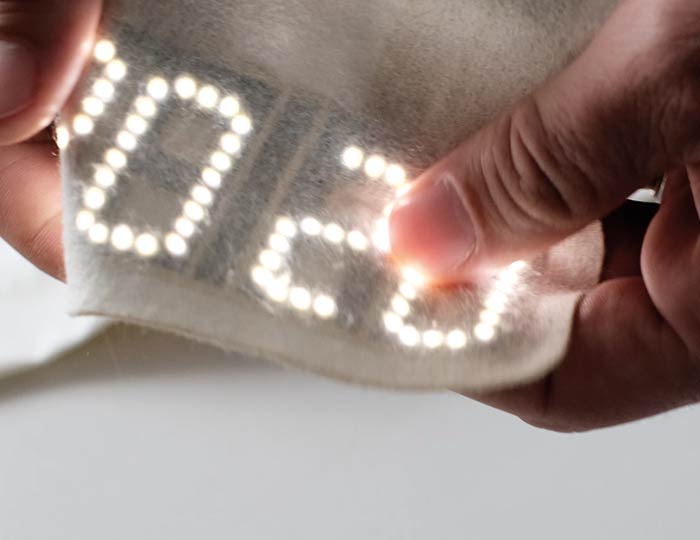
Textile with electronic numbers as a temperature-resistant display for vital signs in firefighter jackets | © Fraunhofer IZM
In the area of e-textiles, you are combining different branches of industry that normally do not necessarily work together. Is this a problem?
Malte von Krshiwoblozki: Well, it took me a while to understand textile professionals. If you come from the field of electrical engineering or microsystems technology and then get face to face with a textile professional, you first have to make sure that you use the same words for the same things. This means that there is a phase of communication in which you need to find common ground, and only then can you start working. By now, however, the topic has been on the table for a long time, and many companies are approaching each other and building up know-how in complementary fields. There are many textile companies that are setting up multidisciplinary teams. There, electronic engineers, chemists, material scientists, and possibly medical people are put together in a team to develop e-textile products.
Also, looking at the manufacturing technologies, microsystems technology consists of soldering, laboratories, clean rooms – everything is highly accurate and sterile. When I come into a weaver’s mill, there are fibers flying around in the air, depending on the material, and everything is only ‘accurate’ to the millimeter.
So it will take a few years until you reach common ground on the industrial side.
Speaking of laboratories: What does a typical day look like for you?
Malte von Krshiwoblozki: Unfortunately, I am rarely in the laboratory. I spend a lot of time on my computer, in meetings, and on the phone, or I travel around to meet customers and project partners. Writing project proposals, reading project reports, making sure projects run etc.
… because you delegate others who are in the lab for you?
Malte von Krshiwoblozki: As a group manager, you do not longer have the time to be really hands-on involved, which is why the scientific staff, technicians, and also many of our students do this. You rather move into a planning, ‘controlling’ role. That might sound boring, but you can still learn a lot as you access much more information.
Are you looking for cooperation partners?
Malte von Krshiwoblozki: Yes, we are always on the lookout for industry partners who want to manufacture e-textiles and use our knowhow to bring new production technologies to the market. We can help them with our comprehensive technology portfolio to realize their innovative ideas.
A final prognosis: In 2017, it was said that 238 million smart clothes will be on the market in 2021. Is this realistic?
Malte von Krshiwoblozki: Of course it always depends on what you count as an intelligent piece of clothing. But, to put it in a nutshell, if you include everything that contains conductive material, I could imagine that number. There are so many companies working in the field. They will get to 238 million by then – easily.
This interview was conducted by Marieke Lienert from Fraunhofer IZM Marketing & Business Development department.

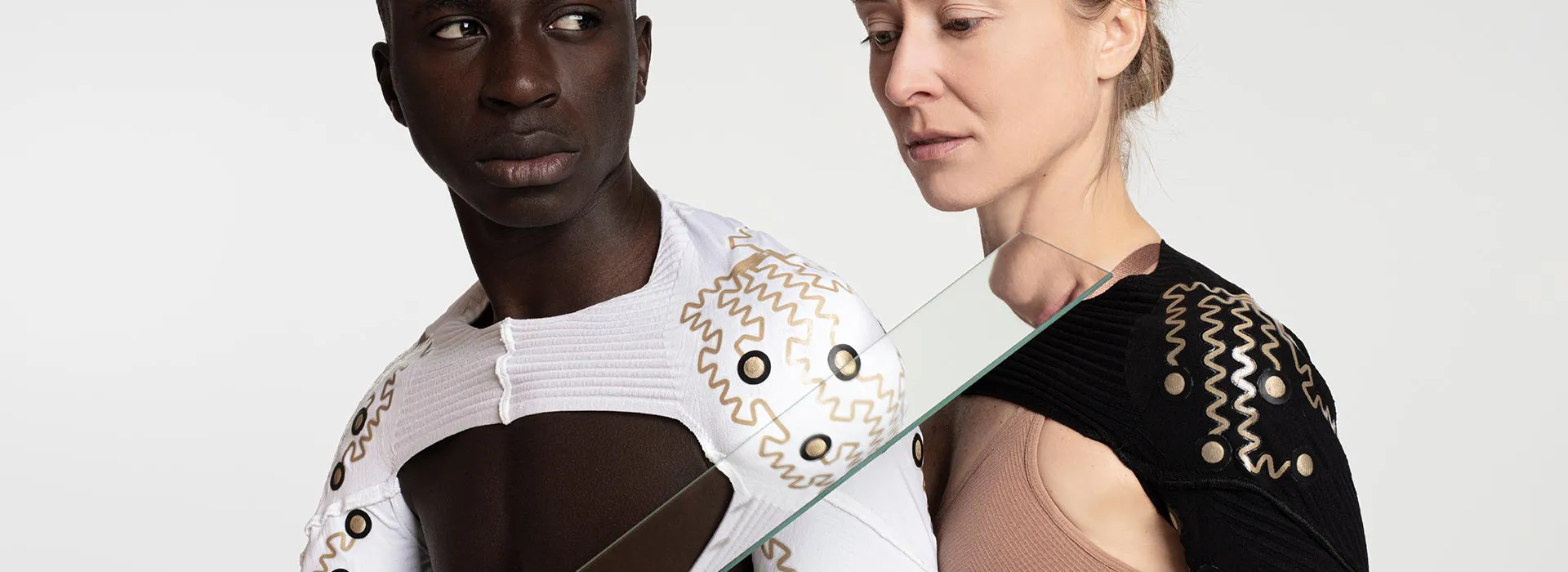
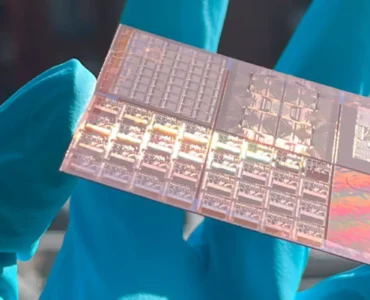
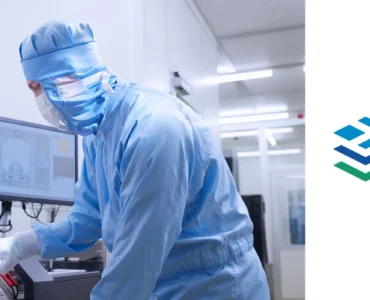
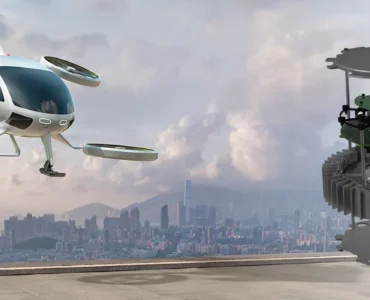
Great content! Super high-quality! Keep it up!
Hello,
we are glad to hear that you like our content. We will keep it up, thank you.
Enjoy your day!
Marieke Lienert
Hiya, I’m really glad I have found this information. Today bloggers publish only about gossip and web stuff and this is really irritating. A good blog with interesting content, that’s what I need. Thank you for making this web site, and I’ll be visiting again. Do you do newsletters by email?
Hello Phillis Blada,
thank you so much for your positive feedback!
There is a subscribe-button below every article. Feel free to join, we would be glad to welcome you to our community.
All the best,
Marieke Lienert
I really appreciate this post. I have been looking all over for this! Thank goodness I found it on Bing. You have made my day! Thank you again!
Hello,
we are always happy to share the excellent work of our scientists. Feel free to contact us for further questions. Enjoy your day!
All the best,
Marieke Lienert
This website was… how do I say it? Relevant!! Finally I have found something that helped me. Cheers!
Thank you. Happy we were able to help you!
Everything is very open with a very clear explanation of the issues. It was truly informative. Your website is very useful. Thanks for sharing!
Thank you for your feedback!
Hi! I’m at work browsing your blog from my new iphone! Just wanted to say I love reading your blog and look forward to all your posts! Carry on the excellent work!
Thank you Kristen, we will!
I appreciate you sharing this post. Much obliged.
I appreciate your comment! Thank you.
Thank you ever so for you blog.Much thanks again. Great.